Universal Design Planning and Design for All
© The Norwegian State Council on Disability
Translation:
Ingrid Bugge from Norwegian
Photos:
Olav Rand Bringa
Edel Kristin Heggem
Anders Dahlquist, Autofill Europe AB, Stockholm
Kjell Norvin
Preface
We must continually seek new ways to improve the conditions of disabled people. New ideas and practical solutions must be sought to bring society closer to the ideal of full participation and equality of status of people with disabilities. New ideas and practical solutions should be investigated to bring society closer to the aim of full participation and equal status.We hope this report represents a step in this direction. We have examined the concept of universal design and discussed it in relation to the principle of equal status, planning, architecture and product design. The report has been prepared by Finn Aslaksen, Steinar Bergh, Olav Rand Bringa and Edel Kristin Heggem commisioned by The Norwegian State Council on Disability, and its contents have been reworked after discussions with the following consultants:
Jørgen Amdam, The Regional College, Volda
Jon Bottheim, The Norwegian Federation of the Organisations of Disabled People
Tore Brantenberg, The Technical University of Trondheim
Jon Christophersen, The Norwegian Building Research Institute
Else Marie Dahll, The Norwegian Federation of Interior and Furniture Designers
Tone Gengenbach, The Norwegian Research Council
Edel Kristin Heggem, The Norwegian association of the Disabled
Ketil Kiran, The National Association of Norwegian Architects
Wilhelm Lange Larssen, The Norwegian Council of Design
Stein Longum, Norwegian Rail, Department of Design
The council would like to thank everybody for the good execution of the work. We also appreciate the valuable contributions from the following people: Anne Alnús, The College of Arts and Crafts/TM, Oslo, Ivor Ambrose, The Danish Building Research Institute, Francesc Aragall, CRID, Barcelona, Spain, Hubert Froyen, Provinciale Hogeschool Limburg, Department of Architecture, Belgium, Guri Henriksen, The Norwegian Association if the Disabled, Oslo, Pip Hesketh, England, Karin Høyland, The Foundation for Scientific and Industrial Research at the Norwegian Institute of Technology, Trondheim, Tore Lange, The Norwegian State Housing Bank, Oslo, Arne Lein, The Norwegian Association of the Disabled, Oslo, Tone Manum, The Norwegian Association of the Disabled, Oslo, James Mueller, Center for Universal Design, North Carolina, USA, Tone Rønnevig, The Norwegian State Housing Bank, Oslo, Harald Zahl, The University of Helsingfors, Finland, James Sandhu, University of Northumbria, Special needs research Unit, England, Odd Walter Syltevik, The Norwegian Association of the Disabled, Trondheim, C. J. Walsh, Dublin, Ireland, Poul Østergaard, The School of Architecture, Århus, Denmark.
The work has been carried out within the project: "Adaption of the Local Environment", which has been a part of The Government's Plan of Action for disabled people, 1994 - 1997. The Norwegian State Council on Disability has been responsible for the project, which has been financed by the Ministry of Health and Social Affairs.
We hope this report will inspire further development of both theory and method to arrive at solutions everyone can use.
The Norwegian State Council on Disability, Oslo, December 1997
Ann-Marit Súbønes
Chair
Anne Margrethe Brandt
Head of Division
Contents
-
Preface
- 1. Universal Design and Equal Status
- The Situation Today
The Paradox
The Principle of Equal Status
The Extended Definition of Universal Design
A Holistic and Inter-Professional Planning Process
The Changing Paradigm - 2. From Theory to Practice
- A New Emphasis to Existing Ideals
A Challenge to Planners and Designers
Principles of Universal Design - 3. Planning
- What is Planning?
How did Planning develop?
What does Universal Design mean to Planning?
What must be done to include Universal Design in Planning?
The Presentation of Plans and the Basis of Decisions
Participation - 4. Architecture
- What is Architecture?
The Historical Development
Architecture Today
The Problem
Could Architecture be developed in the Direction of Universal Design?
Which Changes must take place within the Profession
The Main Arguments for introducing Universal Design into the Architectural Process - 5. Product Design
- What is Design?
The Historical Development
Different Movements of Design
The Situation Today
Could Product Design be developed in the Direction of Universal Design?
Which Changes must take place within the Profession?
The Main Arguments for introducing Universal Design into the Design Process - 6. The Future
Literature
Appendix - Universal Design. Definition, Principles and Guidelines.
The Center for Universal Design, North Carolina State University, 1995
Contents
Introduction
Summary
Introduction
This report attempts to develop and illustrate the concept of universal design.The aim of universal design is to develop theory, principles and solutions to enable everybody to use the same physical solutions to the greatest extent possible, whether it be buildings, outdoor-areas, means of communication or household goods.
Universal design opposes, ideologically and politically, all unnecessary and stigmatizing specialized solutions, whether they are intended for people with disabilities or other groups of the population. Equal status, equal treatment and equal merit are key concepts.
The principles and definitions of universal design developed by The Center for Universal Design, North Carolina State University in USA, are the basis on which we build this report. Their work has brought us one important step further. The thinking related to "accessibility for disabled people", has not been clear enough to counteract unnecessarily specialized solutions or to encourage equal status. The notion of "design for all" is in many ways synonymous with universal design.
The Center for Universal Design defines universal design and the purpose of the concept in the following way:
"Universal design is the design of products and environments to be usable by all people, to the greatest extent possible, without the need for adaption or specialized design"
"The intent of the universal design concept is to simplify life for everyone by making products, communications, and the built environment more usable by more people at little or no extra cost. The universal design concept targets all people of all ages, sizes and abilities."
There are ambitions as well as reservations in the aim to develop solutions usable by all, to the greatest extent possible. People with special needs will require compensatory measures, both in the short and long term, e.g. wheelchairs or hearing aids, to be able to function on equal terms with other people in society. Central to our thinking is a coherent planning process from over all, long-term planning through to the actual solutions.
The discussion in this report covers extensive spheres such as planning, architecture and product design. One may object that we try to cover too large an area within a relatively brief report. It is therefore important to emphasise that our main intention is to include more professionals and politicians in the further discussion of universal design or design for all.
Summary
Universal Design and Equal Status
In the concept of universal design there is both a vision and a concrete attempt to plan and realise all buildings, environments and products in such a way, that they could - to the greatest extent possible- be used by everybody, by children and old people, people of different sizes and abilities, disabled and nondisabled persons.Equal status, equal treatment and equal merit are notions central to universal design. Inherent in these notions is the ideal that everybody should have the same possibilities to participate in different areas of life, e.g. education, work and leisure. There is a clearly defined ambition in the ideology and practical work with universal design that: all products, buildings and surroundings shall be made to be used on equal terms by as many as possible.
The notion of equal status forces us to think in a holistic way, and to consider physical and other kinds of planning together.To make explicit the inclusive and holistic as a basis for universal design, we have extended the definition from The Center for Universal Design, where we, in addition to the design of products and environments, to the greatest extent possible, stress the composition of different products and environments.We are about to move away from a split paradigm, where different spheres have focused on part- and specialized solutions, to what we may call a holistic paradigm built on ideals of equal status and equal treatment.
From Theory to Practice
- 1.Equitable Use
2.Flexibility in Use
3.Simple and Intuitive Use
4.Perceptible Information
5.Tolerance for error
6.Low physical effort
7.Size and Space for Approach and Use
Planning
Planning has developed to include an increasing number of subjects and fields. It now includes social activities in many areas, from land use to planning related to education, health- and social services and cultural activities, or planning based on different groups of the population.
The choice of solutions usable by all, without unnecessary specialized solutions or aids, could be applied in several areas
of planning. This applies to over all and long-term planning and planning within different areas. The thinking and principles
of universal design have so far hardly been applied within planning. It is therefore necessary to increase our knowledge of
what exactly excludes certain groups of the population in different areas of society, and a methodology is needed to throw
light on the consequences for different groups of the population during the whole planning process. To achieve more
universal solutions it is necessary that these groups genuinely participate throughout the whole process from an early stage.
Architecture
The aim is usability by all, as an integrated quality of architecture. There are no inherent conflicts between the definitions of architecture and universal design.However, architecture has not been characterized by having everybody as the object of functionality. Other factors have been more decisive for the design. In the past few years, there has been a development towards considering groups with special needs. This has often led to specialized solutions in additon to normal solutions. This leads to a segregation of groups within the population. The solutions are often minimized, whether they are related to new projects or adaptions of existing ones. In addition, these solutions are often more expensive than integrated solutions which take everybody into consideration.
Society today raises its expectations of environmental design. Functional requirements and demands on resources are
becoming increasingly important in architecture and building. To develop the profession of architecture in the direction
of universal design, we have to see usability for everybody as one of the factors which gives us a beneficial environment.
The principles of universal design could be regarded as one component of a quality-assurance process of functionality,
from the start of the project to the final result.
Product Design
Design is a discipline which is sometimes orientated towards a purely technical aspect, and sometimes towards aesthetic or purely user aspects. The designer is therefore always in a situation of choice between idealism, artistic display or a pragmatism that demands common sense. Traditionally, not many designers have been preoccupied with ergonomics. Products characterised by good aesthetics, as well as ergonomic adaption are rare. User-friendly products are often characterised by having special customers and groups of the population as objects for the design, as well as having the character of specialized aids and products.
Today's design is characterised by trends which often cultivate particular ideologies or fashions. There is a development
towards an increasing number of products and more specialisation, where the groups which are the object of the design,
as well as the requirements of the product, are decided on before the design process starts.This complicates the situation.
The introduction of the principles of universal design would make it possible to change and extend the target groups,
and also change the functional requirements of product design. The sphere of product design is large and includes a vast
number of different products. We should therefore realise that there will always be products characterised by such
specialized user-areas or target groups, that they cannot be adjusted to everybody. However, products usable by as
many as possible acquire a new dimension; a smaller number of products will be needed, and this may signify an increase
in the marketshares for designers and producers.
The Future
The aim of universal design for environments and products challenges several professions and spheres of production. We are on the eve of a further evolution as regards developing theories and methods, both within and between the professions. The aim is a constant improvement of solutions for buildings, environments and products. The solutions and the consequences of the choices which have been made, must be documented and published. This demands more international cooperation than has been the practice until now.1. Universal Design and Equal Status
Today's situation
During the last 20 - 30 years, a constant improvement of both buildings and outdoor-areas towards usability by all, has taken place. This development has been most evident in public buildings and dwellings with a lifespan standard. The solutions have constantly improved technically and aesthetically, in particular where accessibility has been integrated at an early stage of the planning process.Despite this positive development, we can still observe many defects and poor solutions. Lack of knowledge or money still result in poor accessibility.This also includes measures required by, e.g. the Building Regulations. Some of the measures are carried out inadequately and, as a result, with a lower degree of functionality than necessary. This is related to the knowledge and competence of planners, architects and builders, but it is also related to an understanding of equal merit and possibilities of participation for everybody.
We experience solutions which are exclusive and stigmatizing because people with disabilities have to use separate entrances and are limited to particular seats in trains, cinemas or sports arenas. There seems to be an ambition to achieve a technical accessibility, but less focus is placed on including everybody. The solutions of service dwellings for specific groups of elderly and disabled people may, by their position, design and the use of materials, signal a ghetto consisting of people in need of care (Jørgensen 1991).
There is no doubt, that accessibility for people with physical disablilities has been better taken care of, so far, than the considerations of other groups of disabled people.There are several reasons for this. The needs of people with physical disabilities, wheelchair-users in particular, are easy to see. One step may prevent an individual from entering a building. Research work has been carried out for a long time in this area, there are more concrete proposals for solutions and the activity of information has been higher than in other areas. People with physical disabilities constitute, by far, the largest group of disabled persons. This group also includes people with heart- and lung-conditions, who have problems with stairs and steep slopes. A great deal remains to be done before physical accessibility has been sufficiently developed for people with physical disabilities, in addition to a series of challenges as regards the reduction of barriers in the physical environment for people with limited sight and hearing, people with environmental handicaps (asthma\allergies) or for people with learning disabilities. There are also conflicts that need to be solved between the different considerations. The low level pavement kerb has been the classical problem and conflict between blind people and wheelchair users, but this is about to be solved.
The considerations for disabled people are central to the ambition of universal design. These considerations should also, however, be seen in relation to the needs and wishes of the rest of the population, whether they are children, elderly, women or men, or people of different ethnical backgrounds and traditions. In these areas, there may also be different interests and conflicts in the attempt to apply, to as great extent as possible, a universal design in buildings, outdoor areas and products. The different needs of disabled people are central, but not sufficient when we are to plan and design for the whole population.
More effort in research and development is necessary to understand the various needs and wishes of the population and
to develop this into new solutions.
The Paradox
It is our claim that, despite the many attempts to achieve physical accessibility in buildings and outdoor-areas, this field is not embraced with great interest by either planners, engineers, architects, product designers or builders. One of the reasons for this is that little weight has been put on the subject by the schools and universities that educate these professionals.Dwellings with a lifespan standard are still perceived by many, also by planners and designers, as a specialized solution for elderly and disabled people, and not as a basic standard for the planning of dwellings usable by all through their entire life.There is something paradoxical in this situation.
In Norway and other Western-European countries, we estimate that 19% of the population are people with disabilities, having permanent problems relating to essential areas of life. Disability is clearly related to age, 70% of all disabled are over 45 years (Barth 1987).There will be an increase in the number of disabled between now and the year 2005, due to the increase in the share of old people in relation to the population as a whole. A series of investigations show that permanent disability has an effect on the possibilities for education, work and social participation. In addition, there are people with minor difficulties related to movement, sight or hearing, due to the natural process of aging, but who do not appear in statistics as being disabled. Most people are temporarily disabled during their lifetime due to illness or injury.
Accessible buildings, environments and means of communication do not only serve those with different and various degrees of disability. They also facilitate everyday life for e.g. parents with small children, be it elevators in buildings or low floor buses. Buildings and environments where it is easy to find ones bearings, serve, not only persons with physical or cognitive disabilities, but it is something everybody may benefit from. Explicit and logical signboards could serve as an example. This is also of use to people who do not understand the local language. The needs of people with disabilities make several considerations of accessibility more explicit. Heavily polluted air leads to immediate illness among people with asthma, but in the long run may also damage other people's health.
Despite the fact that accessibility is a positive aspect for a large part of the population, it is still looked upon as a field of specialized care. The sociologist Yngvar Løchen is interested in the word "they" in the article "Weak, marginalised and without power". Løchen says: "The personal pronoun they marks and strengthens the dissociation of disabled persons, and this dissociation indicates that people with disabilities are exposed to an alienating process of being categorised. Through this process disabled people are marked as a group different from others, consisting of similar human beings without individual features. This dissociated group is then being characterized by particular properties, something which is common when we speak of the others - irrespective of whom this category consists of " (Løchen 1996). These, both conscious and unconscious psychological processes, are angled, by the philosopher Harald Ofstad, towards a discussion on "our contempt of weakness", something he believes to be deeply rooted in our Western culture (Ofstad 1979). The social scientist Cristoffer Lasch has a third approach towards this discussion in his book "The Narcissistic Culture" where he claims that, people in Western society become more and more narcissistic (self-centered) and that a significant feature of the narcissistic individual is the fear of getting old (Lasch 1979).
Our conscious and more unconscious reflections in this area are mirrored by the use of the word elderly and disabled. Elderly people who are dependant on a walking frame, will sometimes dispute the fact that they are disabled. Young disabled persons also reject being mentioned together with elderly people. There are good reasons for these protests, because young and old are often put into the same service system. However, our general tendency not to accept getting old also exists as an idea among people with disabilities.
In the new slogan of "planning for our future selves", there is, in many ways, a new comprehension that the consideration
of disabled people in planning does not only imply the others, but is actually a more realistic understanding of the entirety
of our lives. This signifies a comprehension rather than a displacement of the fact that we are all getting old and thereby
more disabled.
The Principle of Equal Status
The principle of equal status is made a distinct part of the new professional discussion and development related to the concept of universal design. This principle is expressed in the ambition that all physical products and the environment, in a wide sense, should be usable by all. By equal status we imply that everybody, including disabled persons, should have the same possibilities to participate in different areas of life, to the greatest extent possible, e.g. in relation to education, work and leisure, and not be confined to special solutions and measures. Equal status also implies equal treatment, which means that all individuals should have the same right to services. This is , in many ways, a further development of democracy with a clear emphasis on the fact, that people with disabilities should be able to participate fully in social life on equal terms with people without disabilities. There are clear parallels to the notion of equal status related to gender and ethnical background.It is important to emphasize that equal status and equal merit are not identical. If we only talk about equal status, the result may be that the requirements are laid down by others than the people concerned. This could imply that men lay down the conditions of equal status for women, or that people without disabilities define the aims of equal status for disabled people.
The subordinate clause in the definition, to the greatest extent possible, opens up for a discussion about several aspects of the ideal of equal status. An individual may be dependent on a special solution to be on equal status with others in, e.g. education or at work. Some extencive disabled persons might, for a long period of time, be dependent on specialized means of transport to manage their education or work situation. One disabled person might be dependent on specialized or compensatory measures to have an equal status in working life. If one is left with using general measures only, e.g. if only public transport was available, the aims of equal status related to work , education or leisure could be damaged.
Disability, in relation to the physical environment and products, is often defined as a disparity between an individual's
ability to function and the demands of the surroundings. This incongruity, or gap, may be reduced or conquered through
a general and universal design of products, buildings and environments, and in addition, through specialized and
compensatory measures and adaption, if necessary. The specialized solutions, e.g. hearing aids or wheelchairs,
compensate for individual functional reductions and contribute to the individual's functional ability. The use of specialized
aids puts a demand on the design of environments and products, to make equal status and participation possible.
The design of environments and products on the basis of "the average human being" will increase the need for special
measures, and make the solutions generally more expensive and more complicated, e.g. the use of lifting-platforms and
package-openers. Universal design is based on the fact that people have different abilities, and this should be reflected
in both the planning process and in the ultimate solutions. In the ideal of universal design there is a clear ambition that all
products, buildings and environments should, with time, develop in such a manner that they are usable on equal
conditions, by as many as possible.
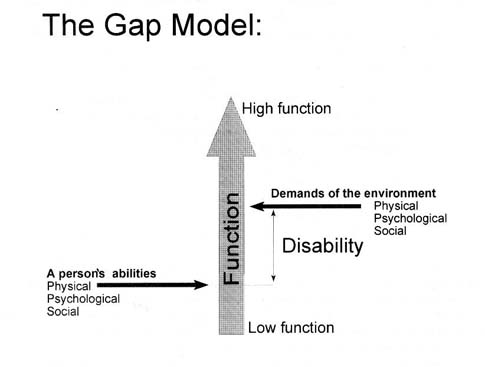
By universal design the gap may be reduced between the person's abilities and the demands of the
environment.
The extended Definition of Universal Design
The notion of equality of status related to universal design forces us to think in larger entities, and to see physical, economic and social planning coherently. The aim is to participate with others in the various activities of society. The perspective is to work towards an increasingly greater organisational integration. Examples of this may be to build dwellings of lifespan standard as part of ordinary housing areas, and to supply them with the necessary services, and thereby to avoid specialized housing solutions and care, to the greatest extent possible.Universal design deals not only with a building or a means of transport being physically accessible, but it also deals with their social connections. Making the relation between physical and social planning visible is called inclusive planning by the architect Jim Sandhu, (Sandhu 1995).The connections between the different physical components could profitably be a more explicit part of the definition of universal design. We therefore propose the following addition at the beginning of the definition developed by The Center for Universal Design:
"Universal design is the design and composition of different products and environments to be usable by all people, to the greatest extent possible, without the need for adaption or specialized design".
One should also discuss, if the definition could be made more obvious as regards equal status; the fact that physical
solutions should imply equal terms and possibilities for all. To eliminate unnecessary use of technical aids should perhaps
also be a part of the definition.
A Holistic and Inter-Professional Planning Process
The combination of the different components is a central part of the planning process. As mentioned earlier, the reservation "to the greatest extent possible", forms a part of the definition of universal design. There are several factors implied in this reservation, and they form a logical part of the planning process, from the analysis of the situation to the realisation of the actual design. In working towards a more universal design, we believe that the different factors and arguments related to this process should be made more explicit.
Universal planning and design based on the principle of equal status puts greater demands on inter- professionalism,
than before. Professionals in e.g. town planning, architecture and landscape and product designers should acquire a
wider understanding of the relation of which their design and products form a part. If the aim is equal opportunities for
everybody, all products should be seen as part of a chain, and, as we know, a chain is only as strong as its weakest link.
The equal and inclusive aims may seem new to many of those who are engaged in physical planning and design.
Quite often, the subject itself, and the traditions related to it, are the only frame of reference when proposals for solutions
are worked out. This leads, in many cases, to solutions far from universal design. It is necessary that the new inclusive
perspectives become part of the education for everyone who is going to work with physical adaption and accessibility,
and the need for inter-professionalism should be illuminated by concrete examples and subjects. Methods of
user-participation is a part of this knowledge (Aslaksen 1995).
The Changing Paradigm
The aim and demand for equal status and equal treatment for disabled people forces us to think in greater entities and connections, which again enforce new physical solutions usable by an increasing number of people. Lifespan standard for dwellings and low floor buses are examples of this.There are still many challenges which have not been solved in the area of accessibility, either because of lack of knowledge about possible solutions, or due to different priorities. At the same time, we see an increasingly clear focus on achieving more coherent solutions based on the perspective of equal status and equal treatment.
In the USA, in the 1990's, a strong focus, based on the ADA - legislation was put on universal design (Lindberg 1996). In The Americans with Disability Act from 1990, where equal status and equal treatment, as well as prohibition against the discrimination of disabled persons are mandatory, access to public buildings, e.g. educational buildings, workplaces and restaurants are put into a larger social context.The legislation requires, not only public buildings without barriers, but also that the work and services performed in the buildings should be adapted both to the employees and the public. This implies developing different tools usable by all, including persons with disabilities. This applies to e.g. IT - technology, office equipment and tele-communications. Equal treatment implies that the various services should be accessible in the same way as buildings or premises. This, for instance, would imply that an individual with reduced sight may have the menu read, and that the waiter describes how the food is arranged on the plate. The same way of holistic thinking, as well as thinking in terms of equal status, is also related to other types of private and public services, among other things, public transport.
The ADA-legislation is chracterised by what we may call a notion of fair play. This implies that you, as a customer, employee or student, should have the same rights as everybody else. It is possible, that we, in Scandinavia, are more inclined to make people into clients than is the case in USA.
The philosopher Thomas Kuhn says that a new paradigm must preserve a major part of the ability of solving problems that the old paradigm had, and, in addition, open up for new, and so far unsolved problems (Kuhn 1962). The ideal of equal status has brought forward a more consistent way of holistic thinking and the creation of organisationally inclusive solutions. This is the core of the changing paradigm. We seem to be moving from a reductionist or split paradigm, where the focus has been on part - and specialized solutions and practice within different professions, to what we may call a more holistic model or paradigm.
More holistic and inclusive solutions for different groups of the population depend, to a large degree, on the welfare
policy and the priorities made by the central and local authorities. Professionals involved in physical planning and design
cannot avoid involving themselves in the development of these policies, if they are going to work towards a more
universal design of environments and products.
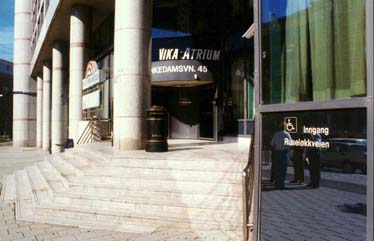
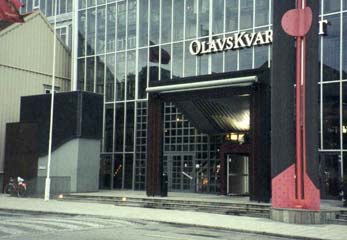
(Left) The entrance to, among other things, a hotel and offices is usable for one part of the population; it is,
however, complicated for a series of user groups, despite the fact that some functional details have been included.
Handrails have been installed, and the steps have been marked by a contrasting colour. The solution excludes, however,
among others, wheelchair users, and separates them from other users. An attempt to compensate for this limitation is
made by referring this user group to a subsidiary entrance at the other side of the building.
A picture from Vika Atrium in Oslo.
(Right) The Olav Building Complex in Trondheim contains a concert hall and a conference centre.
The entrance is one of two main entrances. The solution is weak on several points in relation to providing good
functional conditions for all user groups. A ramp is provided for wheelchair users at the outskirts of the entrance and is
concealed, at the left of the picture. To conceal solutions which cater for the needs of one user group, does, however,
not comply with universal design.
Architects: The Group of Architects for the Mellager District
2. From Theory to Practice
A New Emphasis to Existing Ideals
The theory behind universal design formulates the perspective of equal status more precisely and extensively than is usually implied by the notions Planning for Disabled People. Equal status in the form of social participation has had, and has, a central position in the motivation towards adapting society for people with disabilities. So far, most weight has been put on the effect of the adaptions - the functionality of the technical solutions for disabled people - and less on the solutions own qualities in a perspective of equal status.A major part of the professions involved in the design of the physical environment has all users as an ideal aim for their work. The objects clause of the Norwegian Planning and Building Act 1985, is an example of this:
(section)2 The aim "Through planning and specific requirements for each individual building project the regulations must ensure that area usage and buildings are to the best possible advantage for the individual and society. Special considerations should be made to ensure that children have the best possible environment in which to grow up".
In reality, there is a gap between the ideal of to the best possible advantage for the individual and society and the actual solutions. Many people experience difficulties in using the outdoor environment as well as buildings. It is also a general feature that many of the plans made by the local authorities, e.g. in zoning and town planning, do not further or adhere to the aim of adaption for the individual, implying every individual in society. Disabled people are one of the groups not taken into account.
Universal design emphasises that the demands of all users are to be valued on equal terms. If some considerations have to be excluded, the choice should be made consciously and on a firmly argued basis.
This is an ambitious objective which demands detailed knowledge of subject areas, solutions and consequences of the
choices made. A series of new challenges are implied to solve contradictory demands, to make sure that all accessible
possibilities are exploited to include the demands of the users. Considerations must be given to a larger variety of user
qualifications such as mobility, sight, hearing, understanding and allergy. The solutions should function equally well for
those with average abilities as for people with disabilities. In addition to disabled persons, children should be included
among the users who have needs beyond average. Many functional demands are the same for children, elderly persons
with reduced functional abilities and persons with disabilities.
A Challenge to Planners and Designers
The transition from theory to practice, where all user groups are included in planning and thinking, is a challenge. There are several proposals as to how one could be guided through this process. The Center for Universal Design at North Carolina State University has developed seven principles. In addition, there is a detailed description of each principle. These are printed in the appendix. A summary of the principles is as follows:
Principles of universal design
1. Equitable useThe design is useful and marketable to any group of users.
2. Flexibility in Use
The design accommodates a wide range of individual preferences and abilities.
3. Simple and Intuitive Use
Use of the design is easy to understand, regardless of the user's experience, knowledge, language skills, or current concentration level.
4. Perceptible Information
The design communicates necessary information effectively to the user,
regardless of ambient conditions or the user's sensory abilities.
5. Tolerance for Error
The design minimizes hazards and the adverse consequences of accidental or unintended actions.
6. Low Physical Effort
The design can be used efficiently and comfortably and with a minimum of fatigue.
7. Size and Space for Approach and Use
Appropriate size and space is provided for approach, reach, manipulation, and use regardless of the user's body size, posture, or mobility.
In addition to these principles, considerations must be given to a whole series of other conditions in the process of planning and development. These may include social considerations, economy, aesthetic design, sustainable development, cultural qualities etc.
Work is progressing in several countries to develop tools which can help improve standards in each of these areas and the collective result, when all or several factors are seen in context.
In Norway, we have a reasonably extensive amount of instructive material when it comes to planning for different user groups. This refers to e.g. children, elderly and disabled people. Standards, detailed references and norms exist to guide the practical design. These are of vital importance to the development of good solutions which include all users in a holistic perspective. The holistic perspective, as described in universal design, is, however, not developed systematically and consistently in this material. This is necessary, if the theory of universal design is to be put into practice.
Several professions influence the design of environments and products. Of particular importance is over all and long term planning, land use, engineering, architecture and product design, because they have a major influence on the individual parts of the environment and the relationships between them. In addition, ergonomics is a profession which systematically tries to adjust the functional requirements of the environment to human needs.
We shall continue to take a closer look at how universal design relates to planning, architecture and product design,
to how universal design may be illustrated and the consequences of it's inclusion into the various professions.
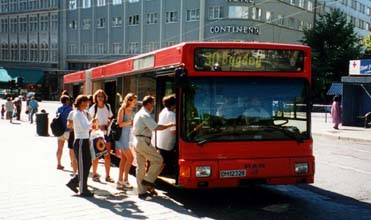
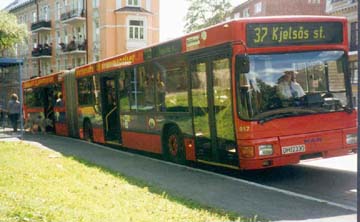
Low floor buses with entrance from bus stops with high level platforms to the right are
more in line with universal design because:
* Principle 1 . The design is useful and marketable to any group of users.
* Principle 2. The design is flexible in use (it facilitates the user s accuracy and precision).
* Principle a. The design is simple and intuitive in use (arranging information consistent with its importance).
* Principle s. The design has a tolerance for error (it minimises hazards and the adverse
consequences of accidental or unintended actons like falling or taking a false step).
* Principle 6. The design demands a low physical effort.
* Principle 7. The design provides adequate space for the use of assistive devices.
Both illustrations are from Oslo, Norway.
3. Planning
Approach
The use of the principles of universal design is assumed in design as well as in the design of the physical environment. The main ambition is usability by everybody, or as many as posssible, in the normal solutions. It would be interesting, however, to evaluate the implications of this notion within the various parts of planning.What is Planning?
We start off on the basis that planning is an activity which seeks to influence the future through actions based on acquired knowledge, experience and interpretation of the past. Planning looks both to the future and to the past. Our definition is as follows:Planning is to influence the future by actions based on knowledge
Planning is, in our context, to influence society by actions based on knowledge. In addition, we comprehend planning as a common denominator for physical and economic planning, as well as planning related to education, culture, health- and social services, environment etc.The design of products, as well as of services, and measures to implement these, demand planning. There is a distinction between planning and the design of products which may be illustrated by a couple of examples:
- * The development of the lifespan dwelling is mainly the design of a product. The systematic work with priorities, financing
arrangements etc. to enable the use of this dwelling is, however, a part of planning.
* Similarly, the development and design of low floor buses is not planning. The development of transport plans, however, with objectives, subsidies etc. necessary to the employment of low floor buses, is a part of planning.
How did Planning develop?
Planning is employed in an increasing number of areas
In town planning, fire and sanitary considerations has dominated until this century. The starting point of planning was a common action to meet the most basic needs which society found it appropriate to meet. Later, economic planning is added. This mainly refers to the period after the Second World War. During the last 20-30 years, planning has been applied to an increasing number of new sectors. These are the health, culture, social and school sector and others. Planning is being applied to an increasing number of areas, and the content of planning has changed from being equated with town planning to include several other areas of society. The three main elements of planning, physical, economic and social planning have developed in the above mentioned order.
In Norway, there has been a similar development in a much shorter period of time in municipal planning. In 1960's, it had a physical orientation, with a land use map as one of the most important products. Later, the content also includes an economic plan, and today, various types of social planning are emphasised more and more.
Another feature of the development is the ambition of a holistic way of thinking. As an increasing number of sectors are included in planning, the question is raised as to the relation between the different sectors in long term, over all planning. Some of the municipal master plans have a clear ambition to make these relations visible.
The distribution of planning into an increasing number of areas are described in the following way by Amdam and
Veggeland in " Theories on Planning" (Amdam/Veggeland 1991):
The modern Western societies are not planned societies. But they could be characterised as planning societies........
The development of planning societies has been a, more or less, continuing process since the 1930's, distinguished by
planning at all administrative levels, and by an increasing number of social sectors which have been subjected to public
planning decision making. In earlier periods, forms of work we now would describe as planning, were also taking place.
It was however, a part of limited and technically characterized areas like town planning and from military, fire and sanitary
considerations and the planning of roads and railways based on transport needs and technical economic considerations
etc. The new implications are that planning has developed into a general phenomenon in society, both in public and
private enterprises.
The notion of planning has been extended to imply any kind of socially aimed activities, from zoning to economic, political
and sociocultural life. In line with current understanding, planning is not only a project, but also a process, which implies as
a consequence, that planning becomes a radical activity in society.
New Considerations and Aims are introduced into Planning
The considerations prominent in planning have varied according to different periods of time. The list below indicates what has been important and which new considerations have been added as time went by:-
Defence
Fire considerations
Sanitary considerations- Hygiene-Health
-
Economic growth
Full Employment
Equalisation of Living Conditions
-
Environment
Women
Sustainability
Children and Youth
Elderly People
People with Disabilities
There is an increasing Focus on Different Groups of the Population
In recent years more attention has been paid to the subject of our planning, and there is an increasing acknowledgement that some groups of the population must be focused on, if they are to be properly taken into account.There has been an increasing focus on the conditions of people with disabilities, and accessibility now plays a more central role in planning. This happens, however, often in sector related plans and not as an integrated part of over all and long term planning. In some of the local authorities, which have accomplished a considerable amount in this area, the ambition has, however, been that these considerations, after some time, should be taken care of within the general planning system.
In Norway in 1989, national guidelines for strengthening the interests of children and youth in planning were approved. This is an example that, centrally, one acknowledges the fact that planning does not automatically cater for all groups, and that a special focus is necessary on certain groups and interests.
Accordingly, women, elderly people and marginal groups have been focused on in planning, where the main objective is
an equalisation of living conditions. A characteristic feature is however, that no collective survey of different groups of the
population is shown. The groups are singled out one by one. Even if this is a positive tendency as regards universal design,
we are still far from a complete survey of how the different groups of the population are affected by planning measures.
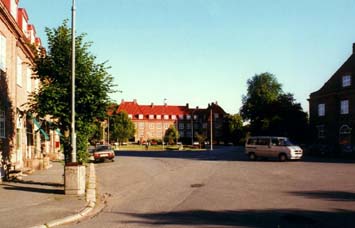

The Ideology of Garden Cities
The idea of the garden cites was introduced by Ebenezer Howard, a theorist on city development, around1900.
The ideas were a response to the crowded and unhygienic housing of the working class at the time.
The thoughts behind the garden cities were based on the idea of sound and beneficial housing conditions.
The houses were lowrise and in areas with small parks and fresh air.The principles were employed in the development
of several working class housing areas in England. Even if Howard's theories of the garden city did not seem to work
out in a wider planning context, the deas have been significant in the development of dormitory towns.
The ideology of garden cities is a true historical example of the exploitation of physical planning and design in the
improvement of important social and medical challenges.
The illustrations are from Ullevål Hageby (Ullevål Garden City) in Oslo, Norway, showing Damtorget
(The Pond Square) and a street with houses. Ullevål Hageby was built from 1915 to 1922. The architects were Hals,
Jensen, Morgenstiere and Eide.
What does Universal Design mean to Planning?
Universal design may be relevant to planning in many areas. A solution complying with the principles of universal design should be usable by all groups of the population. Translated in terms of planning, a more correct assertion would be that the measure should include all groups of the population, except for measures which are directed specifically towards one group. What we then refer to as measures may be proposals regarding physical design, economic measures of support and service supplies, as well as supplies of health and educational services etc. As we have seen, planning has gradually focused on all these sectors, and universal design would naturally be related to these kind of plans. We have taken a closer look at some examples.
Zoning - communication - transport
Physical planning includes everything from over all and principal guidelines of land use, to actual physical design of detailed solutions.To a certain extent, the requirements of design for different groups are part of planning. Demands of accessibility for disabled people are, for example, put on the design of public buildings and road construction. The individual sectors and departments do not seem to recognise, however, that consideration of the whole population is part of their responsibility. For example, the Transport Authorities does not fully accept the responsibility of transportation for everybody, including groups of disabled people. It is looked upon as a responsibility for the Social Services. The main thought behind universal design is not fully catered for, as long as the perspective of equal status is not emphasised. The ambition of usability by different groups is taken care of , but often by offering specialized solutions. When it comes to detailed planning, there is a need to emphasise the principle of equal status, to a larger extent.
Another question is, if equitable use is relevant in relation to a more general development plan, as for example the Municipal Land Use Plan. There is a widely held opinion that, for instance, accessibility for disabled people is something that the planning departments and the design teams should be responsible for, and this is almost uninfluenced, by over all strategic planning.
According to our estimations, this opinion is incorrect. In land use planning as well as in transport planning, many
conditions are implied that would influence unequally the usability by different groups of the population. For example:
- * Housing areas in steep terrain would seem to exclude the part of the population with low mobility and with
problems in moving up steep hills (Wheelchair users, people with a problematic heart condition etc.)
* Areas based on mobility by car are less usable by people who do not use a car. This would include children, adults without a car, and persons with disabilities etc.
* The choice of solutions in public transport influences to what extent this system can be used by different groups of the population. Vehicles usable by everybody should be employed, everybody should be able to understand the information of services and timetables. Distance to stops and access design should not exclude any user group.
* General zoning and transport policies, and the relation between them, influence the level of pollution. This is a general health and environmental problem, but it is of particular importance to people with asthma. Solutions leading to large concentrations of pollution would exclude people with asthma from participating in society.
Economic Planning
In economic planning, there is already, in several contexts, a focus on the fact that the population consists of different groups. Plans are often initiated from a wish to support different groups, or to achieve an equalization. The classification of groups is, however, often done by demographical or geographical criteria, and not according to the individual's qualification in different situations. It may also be the case that measures directed towards specific groups do not meet expectations.
Social Planning and other Areas of Planning
This includes a broad variety of planning in the "new" sectors which are about to adopt planning, often according to a pattern based on the more established physical and economic planning. Planning is governed by different regulations, but at the level of the local authority, it is the Planning and Building Regulations which should co-ordinate the different sectors, and which therefore direct the planning process and methods.Examples of planning in the "new sectors" are health and social plans, culture plans, plans for the adolescent environment and education etc. Many of the plans consist of a physical and economic part, and one part dealing with the design of services within each sector.
In our opinion, it would also be relevant to include the main principles of universal design in these areas. By this we imply that the plans should be based on the acknowledgement that the population consists of many different individuals with different needs and demands. Furthermore, the products and services which are the result of the plan, should be usable by the different groups. The services should also be designed and located to be used by everybody. In the same way that demands are put on the design of physical products based on the ambition of universal design, similar demands should be put on the design and location of services. The demand for equitable use, flexibility, simple and intuitive use and perceptible information could, in principle, also be applied to services.
What must be done to include Universal Design in Planning?
The main objective should be to ensure that different types of plans have solutions which satisfy the demands of universal design.To achieve this, we believe an effort is demanded in four areas:
- * Knowledge of the different groups of the population, and how they are affected by different measures.
* A methodology to cater for the consideration of different groups, and to analyse the consequences for each group.
* Aims which may be of functional use in the different types of plans.
* Participation from different groups of the population which are affected by the planning.
Knowledge of different Groups of the Population
Today we have a general view of how many people are permanently disabled, and what kind of disabilities they have. This information is, however, inadequate. Many people are influenced more than the average, even if they are not disabled. Many have disabilities in relation to injuries or illness. In some cases, investigations are made into the effect of the different measures and this may indicate which groups have been reached by the measures. The information is, however, incomplete and does not give a full account of everybody. We need more information about the practical consequences of different disabilities, and about the number of people with disabilities. With sufficient information about the variations in the functional ability of the population, we should be able to answer the following questions:
- * How large a section of the population is able to use a housing site in steep terrain sited some distance from public services?
* How large a section of the population is able to travel by an ordinary bus, and how many more by a low floor bus?
* How large a section of the population understands the transport companies' ticket machines?
* How large a section of the population is able to use the different support systems to which they are entitled?
A Method to evaluate Needs
An acknowledgment that the population does not consist of the average person but of different people with different functional abilities, would lead to a different way of developing and presenting planning proposals as well as consequential evaluations.Today, we usually measure the consequences in relation to aims of reductions in noise level, air pollution, economic equalisation between different regions etc. In some analyses, the way the different consequences are divided between the different groups affected (children, road-users etc.) is described. Some groups may get the advantages and some the disadvantages. It would be possible to improve this with a sufficient knowledge about the different groups' functional ability. This may be illustrated by a few examples:
1. Consequences of pollution We imagine a developmental measure which will entail a certain level of pollution, which can be estimated in advance. A traditional way of referring to these consequences may be as follows: "The measure will entail a level of pollution (........). This is an increase compared with today's level, but is below the recommended limits". If we include the consequences for different groups of the population, the conclusion may be complemented as follows: "The level of pollution may, however, be too high for people with asthma to stay in the area. The measure may therefore lead to the fact that 5% of the population may not be able to use the area".
2. Location of housing
We imagine a quite normal approach in Norwegian local authorities: There is a choice between locating a housing area on
flat, cultivated land near the municipal centre (alternative 1) and locating a housing area in a steep mountaineous area at a
distance from the centre (alternative 2). There are at least three different consequences which may be described:
a. Developmental economy as opposed to protection of cultivated land
b. Alternative 2 gives an increase in transport
c. Alternative 1 may be used by a larger section of the population than alternative 2.
Normally, point a would be included, point b might be included, point c, however, would
not have been illuminated. Point c must, however, also be solved, if universal design is going to be a part of the consequential evaluation.

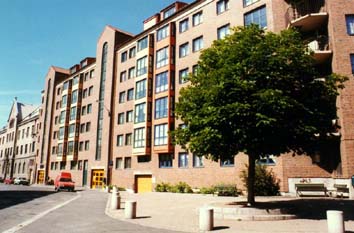
Two housing areas, one in steep terrain at a distance from the city centre.
The other housing area is inside the main city centre. Dwellings as part of small housing areas in steep terrrain ,
at a distance from the centre, lead to a series of problems for people without cars, and who are not in good shape.
There are seldom services (shops, schools etc.) in the areas. There is a lack of public transport due to an insufficient
number of users, and communication within the area is strenuous. The possibilities of achieving universal design are
greater in densely built-up areas, where public transport is established and the walking distance to services is short.
The housing area shown at the bottom is from a rehabilitation area in the centre of Oslo; the flats have lifespan standard.
To the left: Housing area in Bergen, Norway.
To the right: Dwellings in rehabilitation area in down town Oslo, Norway.
The Presentation of Plans and the Basis of Decisions
Functional Aims should be formulated
Planning has always been based on those aims and considerations which the people - who set the tone in a particular period - have valued most highly. We have mentioned the considerations of fire, defence, hygiene etc. that characterised the plans of earlier periods. Irrespective of which philosophy the planning is based on, it is important to develop aims which function in a particular type of plan. It is particularly important to focus on the fact that the population consists of different groups and individuals with different wishes and needs, and to see this in relation to the aim of equal status. This aim is central to universal design, but is often not considered in planning today.
This aim must be made functional in relation to different types of plans. We have seen examples where aims to consider
people with disabilities are included in the chapter describing the aims, and have disappeared later on in the same
document. The aims have thereby not been made functional in relation to the evaluation of different solutions.
The extent to which the aims are achieved must be discussed
As described earlier, the aim of universal design is to achieve solutions usable by all, to the greatest extent possible. Consequently, the demand is not absolute, but should be discussed in relation to other considerations. It should, however, be required that decision makers, and others involved in the planning process have knowledge of which choices and evaluations are made. (See the example of the location of housing). In practice, solutions deviating from the requirement of usability by everybody, should be discussed separately. An argument for modifying the requirement should be available. This implies that "the burden of evidence" should be on those who form the basis of decisions.
Consequences for different groups should be clearly described
Today, consequences are often described in relation to different aims regarding the environment, economy, aesthetics etc. Such a description does not show which groups would be touched by negative consequences, or which gains from the initiative. Who is to gain, who cannot use the proposed solution, how large a part of the population the solution covers etc. are central questions to be answered, if one is to find out whether the intentions of universal design have been met. This discussion presupposes that aims are formulated where the same solutions cater for different groups. This requires an understanding of the different groups making up the population, and how the various groups are affected by initiatives in the different types of plans.
Consequences for those who are not catered for
Even if there is an ambition that the proposed solution should cater for all the different groups of the population, this is not always possible. Solutions for those who cannot be included must then be put forward. They may be catered for by specialized means or by particular support systems. If we comply with this, a holistic perspective would be demonstrated, and we have a basis on which to evaluate how far it is reasonable to stretch the normal initiatives. This is often exposed in separate analyses, and the possibility of a holistic evaluation is thereby lost.
Participation
Extensive participation is practiced in a number of areas today. This applies, in particular, to plans related to physical planning, in developed areas, where there is a clash of interests. In these cases, participation is often necessary to be able to make a decision. At the same time, there is only a small degree of participation in long term, over all planning. In many planning situations there is no participation except for the minimum required by the planning laws and building regulations. The introduction of participation is motivated more by a desire to avoid conflicts than to achieve a better basis on which to make decisions as well as that of achieving improved plans.There are two reasons why participation is important in taking care of the regard for universal design:
- * Participation increases knowledge about the needs of various groups of the population. Planners do not have sufficient
knowledge about this. The information may be mediated by those who participate. This kind of insight, as well as
information, is necessary as a correction and additional information to achieve a good result.
* Participation ensures that consideration for various groups of the population is developed at an early stage. When consideration of different groups is a part of the planning process only at a late stage, there is an increase in the probability of having to choose additional or compensatory specialized solutions, rather than solutions usable by all. Participation at an early stage increases the possibility of achieving a universal design.
To achieve participation according to the intentions of universal design, the planning process itself must be inclusive, it should reflect the ambitions of universal design. This implies that different groups of the population which are affected, must be invited to participate. The meeting rooms should be usable by all, the information received and understood by everybody. Irrespective of skills or professional background, everybody should be able to contribute to the work (Aslaksen1995).
To achieve a beneficial participation process, it is necessary for the plans to have a content, which the different groups can associate themselves with. An awareness that the population consists of different groups must be present in all levels of planning and during all phases of the planning process. The way we present the plans and the basis of decisions, as described earlier, are not only important for the decision makers, they are also important to enable a good planning process.
The way over all and long term planning creates a framework for the later stages of planning, must be identified. Usability
by all seems to be regarded as a task for those who make the detailed solutions, and there is little consciousness as to
how one, through over all and long term planning can lay down the conditions as to what degree usability by all may be
achieved. A higher degree of consciousness about this will be of significance both to planning itself, as well as to those
invited to participate and how this is carried out.
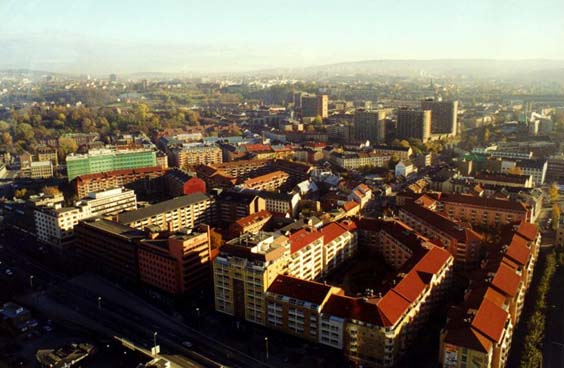
«Old Oslo», a central part of the city, demonstrates a well planned and coherent structure of measures that provide good accessibility for all. The area has a developed town centre with all modern conveniences. There are people with different ethnical backgrounds, and there are some areas consisting of medieval buildings.
The solutions of pathways are coherently and well executed. The township has a large proportion of lifespan dwellings. Playgrounds, kindergartens, schools, shops and public buildings have been repaired to give accessibilty and improved user conditions for everybody. The township is serviced by special minibus services, low floor buses and underground service with good accessibility.
4. Architecture
What is Architecture?
In this chapter, we shall try to unite architecture and the concept of universal design. Two current definitions of architecture will be presented, as well as the definition of universal design. Would it be possible, on the basis of these definitions, to integrate the ideas and the principles of universal design with architectural design and philosophy?Definitions:
-
* Architecture is an organisation of technical possibilities and practical needs based on available resources which, at the
same time satisfies the current spiritual needs. (Odd Brochmann)
* The three foundation stones of architecture are: durability, suitability and beauty. (Vitruvius, 300 B.C.)
* Universal design is the design and combination of different products and environments to be usable by all people, to the greatest extent possible, without the need for adaption or specialized design. (The Center for Universal Design, with our addition, see chapter 1, for the whole definition)
Both architecture and universal design deal with finding the best possible solutions based on practical needs and technical
and economical possibilities. Architecture also emphasises factors of current spiritual needs and aesthetics. The definition
of universal design sets no criteria for aesthetical design and spiritual needs. On the other hand, it requires that the design
is usable by all people. There is no contradiction between these definitions and areas; all people is the aim. This is a
challenge for architects and designers. The fact that, aesthetics and current trends should be considered as well as
functionality, makes it possible to move away from specialized solutions, not only in use, but also within the expression
of the form.
The Historical Development
If we take a look at the trends of architecture throughout the ages, including the current trends, are there any common features and values between architecture and universal design? Functionality and methodology would be natural factors to compare. Could the concept of universal design be integrated or combined and linked with some of the current ideologies and trends?
Architecture has developed according to the prevailing spirit of the time, tradition, position of the center of power, the
power of the church and religion, and to what kinds of buildings were mostly needed during the changing conditions.
Even if Vitruvius as early as 300 B.C. talked about suitability as one of the foundation stones of architecture, - and this
has been one of the elements of architecture - architects and clients have often limited the target groups. The guiding
element has not been that buildings should have equal functionality and usability by all people. In the styles of earlier times,
the craftsmanship, the details of form, the aesthetical expression and tradition were most important.
The Technical Revolution (1850-):
The technical revolution resulted in new materials and possibilities, and the development of architecture started to take a
new direction. The scientific way of thinking and the discoveries which followed, led to experimental research,
particularly in construction.There was an "aesthetic of engineers", where construction and technical and industrial
development and new materials like steel and glass governed design.
Functionalism (1920-1940): As a style, functionalism is characterized as a period ending in the 1930's, but spiritually, it indicates a turning point in the history of architecture. The technical revolution and the new materials and methods of production result in new ways of thinking. The old problem with a new style is solved in a sensational way; one should not look for any style at all. The character of the period and its expression would develop according to the building's appearance as an adequate product where all technical and user considerations have been taken care of, and which is relieved of all bungled details. The construction should be simple, logical and consistent with the materials and the use, both in the design of furniture and buildings. Everything should have its form according to the use and the material.
Functionalism is, in many ways, the style which relates most closely to universal design. The demand of functionality is important in both movements. While functionalism is a movement with a clear ideology of cultivating an aesthetic which removes all unnecessary details and demands pure lines where the design is given by the material and its use, and puts functions and people into standardised needs and solutions, universal design is a method as well as a tool which does not put any demands on aesthetics, but only to the functional demands which are to be achieved.
Functionalism maintained that the use and the materials should determine the design; however, no demands were made as
to usability of all "products" by all people, including people with disabilities. The architects decided and defined the "use"
and the "users" themselves.
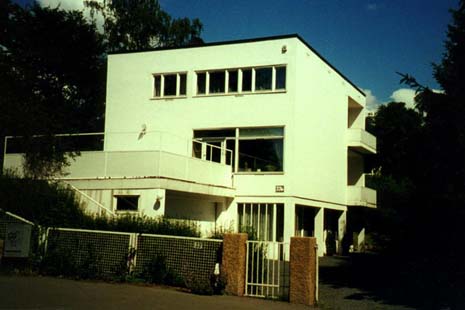
Functionalism
The main notion of functionalism was that the form should reflect the practical functions. The
architecture should develop according to the technical developments in other areas like aircrafts
and cars, and should be rational, simple and inexpensive. A design for the general population
was to be created, with the development of housing and plain interior decorations.
Villa in Oslo, Architect Arne Korsmo 1937.
Architecture Today
Today, we build in an even more functionalist way than before. More advanced building techniques, new use of materials and the production of large elements in factories, lead to external differences, but the fundamental principles are functionalistic. There is no longer one over all ideology of architecture or school of thought which dominates the design and building of today. Architecture today is based on the main principles of functionalism. But the wish to express the needs of our time through creating a distinctive architecture of one's own leads to increasingly new and different architectural expressions. Ways of living and the conditions of production are changing in a fundamental way. Architecture should therefore also be renewed. New materials and forms are presented, at the same time as elements from previous styles are applied, but now in a new way and with new materials. Todays modernism is often about regaining the original with the means of our time.Society today makes ever higher demands on the design of our environment. Functional and material demands are increasingly more important in today's architecture and building culture. Today's planning processes are characterized by: analysis of consequences and needs, infrastructure, efficient construction, conscious use of materials and resources during the building process, user demands, efficient use of the building, fire regulations, flexibility, economy and adaption to and consideration of existing buildings and environments. Laws and regulations in Norway require fire protection, parking - and entrance facilities, indoor climate/ventilation, physical design and, to a certain point, usability by all users.
The situation within the building trade is characterised by increasing competition, stricter deadlines and that one wants increasingly "more for the same amount of money". Economy is often used as an argument to give exemptions, and for priorities that often are at the expense of, for one thing, accessibility by everybody.
At the same time, the new Norwegian building regulations put increasing demands on the qualification of the planners.
One has to document internal quality assurance systems, the responsibility is related more directly to the profession and
there is a possibility for sanctions and "black listing".
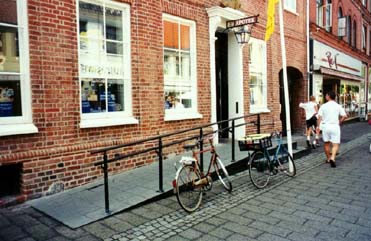
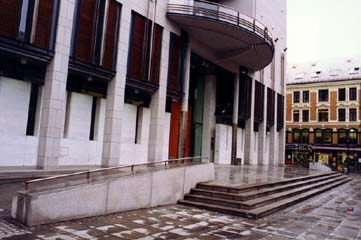
These solutions are equal in principle, and one is as good as the other considering the technical
estimation of accessibility. Both solutions are worked over thoroughly, and durable, good quality materials have been
chosen. The solution at the bottom is more in line with universal design, because it does not stigmatise physically disabled
persons. The entrance without steps is designed as a walking-/driving path, and does not give the impression of being a
specialised solution for the physically disabled. The walking path is equal on both sides.
To the left: A chemist's shop in Middelfart, Denmark.
To the right: The Courthouse in Oslo, Norway. Østgaard Architectual Office, 1994
The Problem
There has been a development towards including the consideration of groups with special needs in society. These considerations, however, have so far been solved by specialized solutions in addition to the normal solutions. This is due to the fact that the demands of disabled people and other groups are often looked upon as specialized demands. Instead of design for all becoming a natural quality and an integrated part of the design and the general solution, these are demands made by, for one thing, the building regulations and by pressure groups, and would often be looked at in the end or subsequent to the ordinary solutions, and are often solved by minimalized solutions. Less holistic and minor solutions are achieved and they often become more expensive than if considerations for everybody had been integrated into the ordinary solutions. Whether it concerns the adaption of existing environments or new projects and products the results are often less attractive solutions which do not comply with the architecture and the form as a whole. This is a clear expression of the fact that these are specialized solutions and not for "normal people" - and a segregation between the different groups of society is created. Today we may find some examples of good architecture and design, where accessibility by all is a natural element which enhances the quality of the prosject. These are, however, the exceptions. Few architects and designers have, until now, accepted the challenge and task of creating projects where accessibility and usability by all people are integrated qualities.
Could Architecture be developed in the Direction of Universal Design?
As mentioned, universal design is not a movement on its own, but a method or technique to guide and influence the design process.The principles of universal design may be used to:
- * Guide and influence the design process
* Influence and acknowledge the signalling of more usable products and environments
* Evaluate existing architecture
Universal design, i.e. usability by all people, should be seen as one of the factors which is to create this totality to give us good environments. The principles of universal design could be regarded as a link in a quality assurance process, which follows the product or project from the beginning of the planning process to the final result.
The design of our environment is no longer only a question of creating beautiful environments and buildings and good
architecture; it also implies, more and more, to satisfy demands of the qualities which should be inherent in the finished
project. Good projects consist of several elements, where aesthetics is only one of these. All factors should intermingle
and form a totality which together create good environments, architecture and design. Universal design or usability by all
people should become a natural and integrated part of architecture.
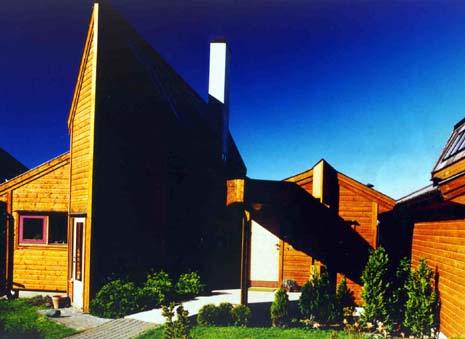
The lifespan dwelling is based on directions in line with the principles of universal design. The lifespan dwelling can be adjusted to different types of architecture and building, and may be combined with other important social aims. This detached house has a lifespan standard and has been made of materials accommodating the needs of people with allergies. The exploitation of energy into heating has been well adjusted, and proper ventilation has been considered to give a good indoor climate.
-
* The design is useful and marketable to any groups of users
* The design demands a low physical effort.
* The main rooms are well dimensioned for elderly and disabled people and for children.
* The use of materials and the indoor climate of the dwelling reduce uncomfortable conditions.
A detached house at Godeset in Stavanger, Norway. The architect is Kjell GrimsÊth, Sandnes, 1988.
Which Changes must take place within the Profession?
The concept of universal design should be a part of the whole planning process, from the analysis of the situation, the sketch design, the aim, the analysis of consequences, functions and needs, the framework, the proposals of solutions including the brief and down to the level of detailing, as well as in all parts of the actual physical execution of the project.
Conflicts
Introducing universal design could imply certain situations of conflict. This could be a feeling of reduced artistic freedom,
opposition against the introduction of more demands and a fear of standardised arcitectural solutions. Even if architecture
today is continually developing, it is tied up in traditions and earlier trends. A change in attitude among architects is
needed, as they have a tendency towards not giving priority to this field. They believe that accessibility for all groups
implies limitations rather than challenges. As regards the fear of reduced artistic freedom, as well as the ties to earlier
traditions, one should look at this as a challenge and try to find alternative solutions which are usable by all people.
One good example of this is the use of steps, which have been an important element in architecture for centuries.
If one develops an additional alternative, and makes it an integrated part of the architectural expression, with a central
position and usable by all, the use of steps may be accepted.
The Main Arguments for introducing Universal Design into the Architectural Process:
Based on the definition of universal design and the seven principles quoted (see chapter 2 From Theory to Practice), we have set up the following five instructive points which are relevant for architecture and the design process. In point 5 we emphasise in addition the relation between the use of materials and indoor climate.
1. The building should be of equitable use and accessible for everybody.
The physical design of the building/project should give all user groups equal possibilities to move about easily and safely
and to use all parts of the building/project. Specialized solutions for particular user groups should be avoided, the normal
solutions should be usable by all.The main access, entrance and the building's internal circulation system should be
designed to allow all groups to use the ordinary solution. If this is not possible, an alternative without steps should be
integrated as an equal part of the normal solutions.
2. The building and its design should be easy to understand and to use by all people.
Ordinary solutions which cater for all groups make use simpler. Complexity and specialized solutions should be avoided.
The main access and entrance should be easy to find and to walk about, and should be usable by all. When the entrance
is an alternative but equal solution, it should be clearly marked to avoid confusion and unnecessary use of effort. Lifts,
staircases, toilets, information etc. should be easy to find and in a logical position. Patterns of movement inside the
building/project should be natural and logical. Alternatives and possibilities should be clearly marked. Signs should be
made of simple, clear and well known symbols and, in important buildings, also with tactile signs and speech. The use
of contrasting materials, colours etc. would be beneficial.
3. The design of the building should demand low physical effort, and be used efficiently and with a minimum of fatigue.
Entrance and use of the building/project should be designed for use by all user groups, which implies that we do not
choose solutions demanding full mobility, great strength and sizes which are only adjusted to walking/standing persons
and to quick pace. Examples of this would be gentle climbing conditions, ramps with gentle slopes, entrances without
steps, handrails adjusted to both walking and sitting, doors which are easy to open or automatic door openers.
A possibility of automatic doors with reduced speed, door handles with a large and simple grip, lifts with automatic
doors and well sized compartments, clear signs and heights adjusted to standing and sitting.
4. The whole building/project should be designed for use by all people, regardless of users' body size, posture or mobility.
All parts of the building/project should be dimensioned for use by all groups. This could imply entrance, rooms and areas
in different parts of the building, doors, corridors, lifts, toilets, barriers, offices, call boxes, telephone slots etc.
5. The building's use of materials and the indoor climate should not lead to uncomfortable conditions.
Use materials which do not damage the environment and which may be used by everybody.Avoid using materials which
could give allergic reactions, i.e. avoid materials which produce waste gas. Avoid carpets, materials and elements which
collect dust. Clean the building/project during construction and before it is put to use. Plans for efficient possibilities of
cleaning the building\project should be made. Correctly dimensioned ventilation and organised and well qualified
supervision of the system of ventilation.

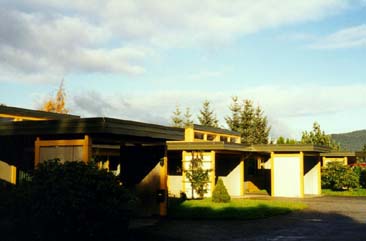
The housing area to the right consists of dwellings with a lifespan standard and is more in line with universal design
because:
-
* The design is useful and marketable to any group of users.
* The design demands low physical effort.
* The design provides more adequate space for the use of assistive devices, and it is dimensioned to cater for everybody.
To the right: Lifespan dwellings at Norås, Bergen in Norway. Vaardal - Lunde Architectural Office by the architect Per Oeding, 1979
5. Product Design
How could the design of products be adjusted to the concept and principles related to universal design.Definitions:
-
* Design is a way of putting together components with the intention of achieving the best solution to a given problem.
(Ch. Eames)
* Design: There is no design with a unilateral content and aim. Design has one common denominator: objects which are formed and created by human beings. Objects in a wide sense, which are conceived, made and obtained by human beings and constitute their" artificial surroundings/environment. The form is far from innocent; an expression of a functional side, but also an aesthetical side, and valued by virtue of communicating something. This duality carries the embryo of the main discussion in design, - which of these sides is to be given priority. (Aubry/Vavik 1992)
* Universal design is the design and combination of different products and environments to be usable by all people, to the greatest extent possible, without the need for adaption or specialized design. (The Center for Universal Design, with our addition, see Introduction,chapter 1 and Appendix)
The content of design is strongly related to various stages of development in industrial society. The result is a discipline which sometimes is orientated towards the purely technical aspect, other times towards the purely aesthetical or user aspects. The designer is therefore always in a situation of choice - often between idealism or artistic display or a pragmatism which requires the use of a "healthy rustic sense".
If one takes a look at Eames' definition, where the basis is a way of putting together components with the intention of
achieving the best solution to a given problem, the definition of universal design is closely connected. Universal design
demands, in addition, to work towards the best solution for all people. Here, both sides of the discussion in design are
addressed; the aesthetical and the functional side. To find a balance between these two elements, where both could
interact, should be the aim and challenge of the product design of the future.
The Historical Development
If we look at the current styles and the design ideologies throughout the ages, -would there be similarities and common denominators with universal design? Could the definitions and principles of the concept of universal design be integrated or combined and linked with some of the existing ideologies and trends in design?
The origin of design has traditionally been dated back to the Victorian times in England. The main sources came into being
simultaneously with serial production. The idea of uniting art and industry was highly in demand within the leading art
movements already in the beginning of the last century.
The Industrial Aesthetics (1929-52)
The extent of technical devices and the continually increasing number of industrially made products necessitated studies where design was related to function. It was a matter of, in each case, to find a simple solution to a technical and functional problem. Functionalism also puts its mark on product design; furniture as well as buildings should serve a purpose. The products should be complete, including all technical and user considerations, and there should be no bungled details.
American Design (1930-1950)
Design was, for the first time, recognised as a profession in the USA. The industry and marketing limited the design, and it was characterised by being a compromise with simplified elements to achieve a more aesthetical form. A fascination with style and aerodynamical forms characterized this period.The Italians have influenced the development of product design since the 30's, and an extensive design policy (presentation of enterprises/image) governed both the development of products, architecture and graphical symbols.
Ergonomics- the Rational Approach (1949-)
Ergonomics is a common professional term of initiatives which systematically tries to adjust the functional demands of the environment to the functional ability of the human being. Ergonomics is problem-orientated and is therefore the principal method in participatory rehabilitation. Many prefer to limit the term ergonomics to work with physical functional demands (Lie 1996).In 1949 an interdisciplinary group of psychologists, architects and engineers, called the Ergonomics Research Society was formed. The word ergonomics was chosen as a name for the activity which came into being. The profession started developing in the USA during the Second World War, when the military situation exploited the technique and the human being to the utmost. At the same time, man's capacity and limitations had to be taken into consideration. In Scandinavia and the northern part of central Europe the profession of ergonomics turned away from the psychological aspect which predominated in the USA. In Sweden, they have concentrated on work physiology, along with which a study of industrial design with an emphasis on ergonomics was established at Umeå University. One of Sweden's largest industrial design offices, "The Ergonomics Design Group" has its basis in the emphasis on ergonomics. In Norway the profession developed with a basis on the research of work and the health service for employees, with an emphasis on injuries due to heavy work load and physical and chemical environmental factors. The profession's entry into product development and industrial design has been slow.
European Design 1960-1970/The New Formalism
Most of the designers in the 1960-70's were architects. Due to the development in architecture, they were influenced by an interest in utilizing the materials in the most rational way. This led to a purification of form and an aesthetical implacability which excluded any attempt at superfluity and decoration. The craftsmanship was dictated by the cooperation between designer and enterprise. A movement, practising a design characterised by briefness and purity combined with a widespread use of nordic timber, came into existence: Scandinavian Design (1950-60's). The functional aspect of the products was emphasised. Series of products with a strong appeal of identification were created due to competition. The 1980's brought reactions and alternatives to the rational design.

The water tap to the right is more in line with universal design than the one to the left. The water tap with one grip could be used by more people and with minimal effort. It has also been given a colour which separates it from the white china and makes it more visible. In addition the tap has a security arrangement to prevent burning. Water taps with screwing arrangements were universal until the 1960¥s, but have been gradually replaced by fittings which may be operated by one grip. The fittings with a screwing arrangement now seem to get a renaissance as rustic products.
Different Movements of Design
- * Industrial Design: Design for industrial production has developed into a separate subject and movement both in
education and among designers. Industrial design may include all products produced industrially. A common term for
several of the design movements presented below:
* "Natural"/Biodesign: Fundamental studies of natural systems. The relation between form and function, user value and aesthetical aspect.
* Artisan Design: The tool decides the form. The individual craftsman came forward with his/her improvements until the tool got its final and perfect design. For example, the tool of the cabinet maker.
* Anonymous Design: Objects which are not formed by a designer. The form is the result of suitability and the satisfaction of the user.
* Engineering Design: The development of industry is the result of engineers and technicians taking over the enterprise. The industry creates the need, opens up the capacity of production and determines the craftsmanship. Designers, artists and architects are the losers.
* Design and "styling": Mainly in the USA in the 1930's. The designer is only dealing with the external look of the product. This type of designer often neglects the demands of economic considerations and quality.
* Marketing Design: Often synonymous with commercial design. The market researchers are autocratic when it comes to deciding on and satisfying the needs of the people, but they also have the main responsibility for the end product. The designer decides on the external form which takes care of this need.
* Design without cost: Is best illustrated by military material. Design which purpose is only directed towards appropriate use and maintenance.
* Graphic Design: Secure visual identification between a sign or a trademark and what it is associated with.
* Environmental Design: The social responsibility of the designer leads to an increasing involvement in environmental questions. This leads to a displacement of responsibility towards social involvement and town planning. A forced growth implies a risk of the natural balance being disturbed, and destruction threatens our existence. Environmentally sound materials.
* System Design: Co-ordination of products to achieve a reduction in the existing number of products without reductions of application, or the possibility of extending the applicability of the product. Simplify, unite and eliminate, demands a new and scientific method of analysis. A link in a whole family of products.
* User friendly design: Social demands and security studies have, together with the technical development and knowledge of ergonomics lead to a new development of e.g. the work place.Use, the elements of the products and the space at one's disposal should be considered.
The Situation today
Design and design processes today are characterized by trends which often cultivate particular ideologies and considerations. The society and market of today are extremely conscious about design, trends and products, and new prosperity leads to increased consumption and purchasing power. This leads to products that are often the result of purely formal considerations, perhaps combined with technical considerations of production, if the products are industrially made. The trend is directed towards an increasing number of products and a larger degree of specialisation, where user groups and demands on the product are often decided before the start of the design process. This complicates the picture. In addition, the area of product design is very large and covers everything from cutlery to trains and planes. Even if we find some cases of design of ordinary products with good design and good functionality for most people, the really user-friendly and ergonomical products are rare. The combination of user-friendly products and good aesthetical design is even more unusual. Products and objects characterized by ergonomics and user-friendliness are often characterised by having specialized clients and user groups, as well as having the character of specialized products and remedies.Traditionally, designers have not been engaged in ergonomics, with a few exceptions in the design of furniture, cutlery and china. There could be many reasons for this. Some believe that the knowledge and method of ergonomics would not improve the product, others think they know everything and regard their own work as setting a standard. In the development of products and systems, emphasis was put on technological innovations and market research, without including design and ergonomics from the start. Cooperation between designers and the profession of ergonomics in general design has just started in Norway. Professor Bengt Palmgran at The High School of Design, University of Umeå in Sweden, has put it this way:
Knowledge of ergonomics and certain sciences of behaviour, in combination with the knowledge of the industrial designer on developmental work, will become a key function in the future process of product development". (Aubry/Vavik 1992)
Could Product Design be developed in the direction of Universal Design?
Universal design is not a design movement but a method or technique to guide and influence the design process.The principles of universal design could,- for product design as well as for architecture-, be used to:
- * guide and influence the design process
* influence and increase the awareness of designers about the characteristics of more usable products and environments
* evaluate existing design
Which changes should take place within the profession?
Introduction of the concept of universal design with its principles, would, in many cases, change and extend the user groups and the functional demands of product design. Introducing the principles of universal design, including the aim of usability by all, would imply that the idea of usefulness and equal status follow the whole design process, and thereby securing the best possible functional result. Universal design as an integrated part of the whole design process, would secure that functional value would play an important role in deciding the aims, in analysing the user requirements, in seeking the solutions and deciding the priority of the different components. ConflictsThe trend today is towards a greater degree of product specialization and an increasing number of products with limited and defined user groups. Often there are particular products within the sector of each group. This is a development in the opposite direction, and it could stop the development towards a more universal design. In addition, product design is a large and heterogenous subject. Some products will therefore continue to have such specialized areas of use - or user groups, that usability by all will not be possible.
Designers and producers should, however, accept the challenge to make products usable by all people, because it would add new qualities to the product, demand a smaller number of products and could give them a larger share of the market. Universal design seems, in addition, to be an international trend and may become a future demand within all areas of planning and design.
The Main Arguments for the Introduction of Universal Design in the Design Process
All the seven principles of universal design developed by The Center for Universal Design are particularly applicable in product design (see the principles, chapter 2, and Appendix). Product design is, however, a vast and heterogeneous area. It is therefore difficult to describe the area by the use of examples, and all the seven principles with their guidelines would not apply and be relevant to all products. Some products would , by their area of use, have specialized user groups and would not be of current interest to everybody. Therefore, it would be necessary, in many cases, to adjust and to make priorities within the various fields of products. However, the principles, as they are defined today, cover, to a large extent, the fields, where it may be of current interest to adjust the products to as many people as possible.
Razors from Gillette (to the left) and Wilkinson Sword (to the right). Due to new developments, the functionality is
increasing. Gillette gives priority to a grip which secures a firm control with the assistance of rubber ridges.
Wilkinson Sword has developed a grip where the hand is supported by the palm of the hand to achieve better
functionality for larger user groups.
6. The Future
Universal design is one answer to important challenges in society and to challenges which will increase in the future. We have seen that universal design has common traits with several other planning-, architectural- and design movements which have changed our environment. There are no fundamental differences between the general thinking of planning, architecture and product design and universal design. On the contrary, universal design is essential to good functionality and usability aspired to in all design. Universal design does not indicate a direction including an ideal of form, to the same degree as for example functionalism, and does not therefore present itself as a new design language.The thinking related to universal design discusses the fact that large user groups are not able to use the products and the physical environment which we produce, and that it prevents them from participating in society. The other side of this is that the extension of one product's user group may give the producers an increase in the share of the market, and the authorities may reduce specialized measures.
At the same time, universal design is directly related to an ideology with key words like, equal status, equal treatment and equal merit. Other basic concepts which are emphasised more strongly in european discussions about universal design or design for all, are democratization and multiplicity. An increasing number of terms are introduced during the process in the attempt to give a good description of the direction of our work. User centered design is only one such term. The discussion about universal design is on the way and should be kept alive.
Functionality in universal design must be introduced together with several other important elements like aesthetics and economy, and it should enter into new social adaptions like sustainable development.
Universal design has come into existence as a generalization on the basis of design for disabled people. It challenges a series of subjects and spheres of production. It is important to keep all these areas of work , to investigate them continually and to seek new solutions which may vitalise the development. The interaction between theory and practice should be present in the further work on universal design.
There are several areas that can be developed further:
Theory
The theory of universal design may currently be discussed from different sides. It would be particularly interesting to look into design that would include everybody in relation to the notion of democracy, the principles of equal merit, the notion of solidarity and the discussion on human rights. There is also a need to clarify if there are contradictions as regards ideology and interests between planning for disabled people and planning for all. The apparatus of notion should be clarified, in particular.It is also desirable to discuss further the user areas of universal design. Are there any areas where the distinctive character of some of the user groups should be expressed more clearly in the design? One example of this may be the environment of children.
Methods
Universal design demands a methodology to be able to handle a large number of user needs in the development of solutions. This would also be fundamental in order to put theory into practice. There is also a need for a basic discussion in this area. Should we employ the existing analysis of function, norms and standards for different groups of disabled people and others, and develop a common specification of demands on the basis of this, or should we seek for completely different angles of approach? The last approach may imply to liberate oneself from the notion of diagnosis and groups, and to develop new, general analysis of function, based on what a representative selection of the population could manage with a good margin.Conflicts will arise during the process of handling the different demands of the users. There is every probability that the contradictory demands at issue may seem inextricable. In order to prioritise the effort in relation to practical work, both demands which coincide and those which conflict should be clarified. It is inexpedient to spend a lot of time on what has already been clarified professionally, and this would be important to know when entering into a complicated and time consuming area. A number of people ask for proof of methodology in the shape of check-lists, work-routines, norms, standards and examples. Much emphasis should be put on this in the additional work.
Beneficial solutions cannot be achieved without participation by those who are affected. The work must continue to develop this as an integrated part of the process of planning and design.
Solutions
Imperfection in theory and methodology should not be interpreted as an obstacle in implementing universal design in practice. It is basic to the notion of universal design, that we all the time, as far as possible with the currently existing knowledge and technology, make the physical environment more usable by all in current production and development (Bringa 1995).In addition, the design of projects where it is posible to work with the approach to these problems in particular would be important. Pilot-projects, as well as projects with employed research and experiments would be of great importance. Such projects should be accomplished within each particular profession, as well as, to the greatest extent possible, inter-professional tasks.
Documentation of results and consequences
Arguments based on the notion of cost and benefit would be of great practical significance. A documentation of social economy as well as of business economy would be interesting together with quantitative and qualitative analysis of living conditions and quality of life.Social economic evaluations have been on demand for a long time with the introduction and use of lifespan dwellings. Such analysis should be carried out in this as well as in other sectors. The effect of universal design as a preventive measure is of particular interest in relation to children and disabled and elderly people.
Publicity
To publish ideas and results would be a key to further development as well as to the accomplishment of the ideas. Both national and international channels would be used. It is of current interest to engage both public and private enterprises, as well as the educational system.
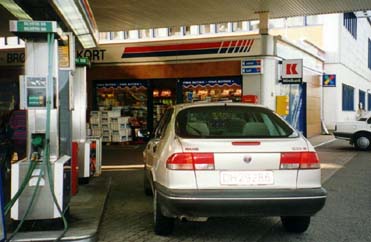
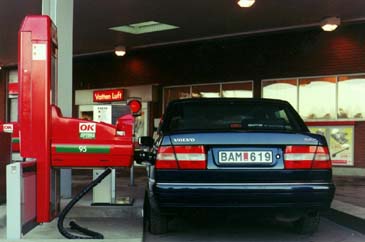
Solutions more in the line with universal design are made possible by highly specialized technology. Servolink (top) is an
infrared system of warning which can draw the staff's attention to the fact that costumers at a service station need
assistance to fill up. This is mainly a compensatory measure for people with disabilities.
New petrol pumps with automatic filling are now being tried out (right). This solution provides the same means for
everybody.
The illustrations are from Oslo and Stockholm
Literature
Ch. 1 Universal Design and Equal StatusBarth, Erling: People with Disabilites in Norway, Oslo 1987 *
Jørgensen, Ivar: Satisfactory solutions ?, Oslo 1991 *
Kuhn, Thomas: The Structure of Scientific Revolutions, Chicago 1962
Lasch, Christopher: The Narcissistic Culture, Oslo 1982
Lindberg, Lars: The American Solution, our Future Model of Handicap Policy, Stockholm 1996 **
Løchen, Yngvar: The Disabled, Oslo 1996 *
Ofstad, Harald: Our Contempt of Weakness, Oslo 1972
Sandhu, Jim: A Holistic Approach to the Design for All Concept, Newcastle 1995
The Center for Universal Design: Universal Design, North Carolina State University 1995
Ch. 2 From Theory to Practice
Ministry of the Environment/Ministry of Local Government:
The Planning and Building Act, Oslo1997
Ch. 3 Planning
Andam,Jørgen/Veggeland: Theories on Planning, Oslo 1991 *
Aslaksen, Finn: User Participation in Planning, Oslo 1995 *
Ministry of Environment: Regional Planning and the Policy of Land Use,
Parliament white paper no 29, Oslo 1997 *
Ch. 4 Architecture
Brockmann, Odd: Architecture, what is it ?, Oslo 1986 *
Ch. 5 Product Design
Aubry, Didier and Vavik, Tom: Product Design, Asker 1992 *
Lie, Ivar: Rehabilitation and Habilitation, Oslo 1996 *
Ch. 6 The Future
Bringa, Olav: Fairleader- Planning of Local Environments for people with Disabilities, Oslo 1995; new edition 1998 *
* only in Norwegian ** in Swedish
Appendix
Universal Design
The design of products and environments to be usable by all people, to the greatest extent possible, without the need for adaptation or specialized design. The authors are involved in a collaborative effort to establish and validate universal design principles to guide a wide range of design disciplines including environments, products, and communications. A working group of architects, product designers, and environmental design researchers has identified seven universal design principles for use in evaluating existing designs, guiding the design process, and educating both designers and consumers about the characteristics of more usable products and environments. The seven principles are presented here, in the following format: name of the principle, intended to be a concise and easily remembered statement of the key concept embodied in the principle; definition of the principle, a brief description of the principle's primary directive for design; and guidelines, a list of the key elements that should be present in a design which adheres to the principle. (Note: all guidelines may not be relevant to all designs).Definition
Universal design is the design of products and environments to be usable by all people, to the greatest extent possible, without the need for adaptation or specialized design. The intent of the universal design concept is to simplify life for everyone by making products, communications, and the built environment more usable by more people at little or no extra cost. The universal design concept targets all people of all ages, sizes, and abilities.
Principle one: Equitable Use
The design is useful and marketable to any group of users.
Guidelines:
1a. Provide the same means of use for all users: identical whenever possible; equivalent when not.
1b. Avoid segregating or stigmatizing any users.
1c. Provisions for privacy, security, and safety should be equally available to all users.
Principle two: Flexibility in Use
The design accommodates a wide range of individual preferences and abilities.
Guidelines:
2a. Provide choice in methods of use.
2b. Accommodate right- or left-handed access and use.
2c. Facilitate the user's accuracy and precision.
2d. Provide adaptability to the user's pace.
Principle Three: Simple and Intuitive Use
Use of the design is easy to understand, regardless of the user's experience, knowledge, language skills, or current concentration level.
Guidelines:
3a. Eliminate unnecessary complexity.
3b. Be consistent with user expectations and intuition.
3c. Accommodate a wide range of literacy and language skills.
3d. Arrange information consistent with its importance.
3e. Provide effective prompting for sequential actions.
3f. Provide timely feedback during and after task completion.
Principle four: Perceptible Information
The design communicates necessary information effectively to the user, regardless of ambient conditions or the user's sensory abilities.
Guidelines:
4a. Use different modes (pictorial, verbal, tactile) for redundant presentation of essential information.
4b. Provide adequate contrast between essential information and its surroundings.
4c. Maximize "legibility" of essential information in all sensory modalities.
4d. Differentiate elements in ways that can be described (i.e., make it easy to give instructions or directions).
4e. Provide compatibility with a variety of techniques or devices used by people with sensory limitations.
Principle five: Tolerance for Error
The design minimizes hazards and the adverse consequences of accidental or unintended actions.
Guidelines:
5a. Arrange elements to minimize hazards and errors: most used elements, most accessible; hazardous elements eliminated, isolated, or shielded.
5b. Provide warnings of hazards and errors.
5c. Provide fail safe features.
5d. Discourage unconscious action in tasks that require vigilance.
Principle six: Low Physical Effort
The design can be used efficiently and comfortably and with a minimum of fatigue.
Guidelines:
6a. Allow user to maintain a neutral body position.
6b. Use reasonable operating forces.
6c. Minimize repetitive actions.
6d. Minimize sustained physical effort.
Principle seven: Size and Space for Approach and Use Appropriate size and space is provided for approach, reach, manipulation, and use regardless of user's body size, posture, or mobility.
Guidelines:
7a. Provide a clear line of sight to important elements for any seated or standing user.
7b. Make reach to all components comfortable for any seated or standing user.
7c. Accommodate variations in hand and grip size.
7d. Provide adequate space for the use of assistive devices or personal assistance.
It must be acknowledged that the principles of universal design in no way comprise all criteria for good design,
only universally usable design. Certainly, other factors are important, such as aesthetics, cost, safety, gender and cultural
appropriateness, and these aspects should be taken into consideration as well.
The principles of Universal Design
Version 1.1 - 12/7/95
Compiled by advocates of universal design, listed in alphabetical order: Bettye Rose Connell, Mike Jones, Ron Mace, Jim Mueller, Abir Mullick, Elaine Ostroff, Jon Sanford, Ed Steinfeld, Molly Story, and Gregg Vanderheiden
Major funding provided by: The National Institute on Disability and Rehabilitation Research, U.S. Department of Education
Copyright 1995, The Center for Universal Design, NC State University.

